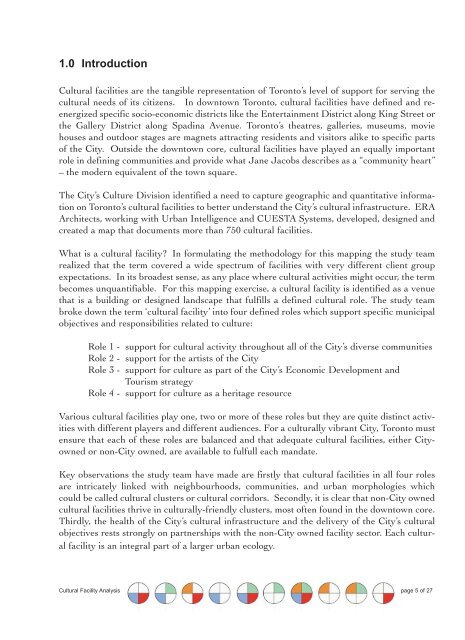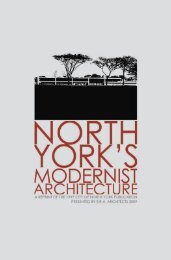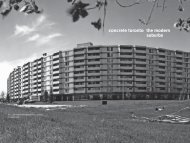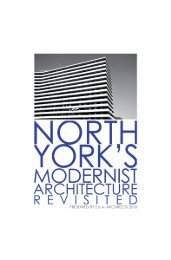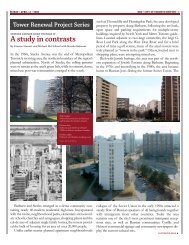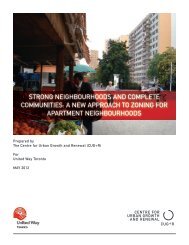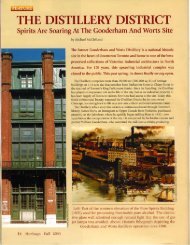A Map of Toronto's Cultural Facilities - ERA Architects Inc.
A Map of Toronto's Cultural Facilities - ERA Architects Inc.
A Map of Toronto's Cultural Facilities - ERA Architects Inc.
Create successful ePaper yourself
Turn your PDF publications into a flip-book with our unique Google optimized e-Paper software.
1.0 Introduction<br />
<strong>Cultural</strong> facilities are the tangible representation <strong>of</strong> Toronto’s level <strong>of</strong> support for serving the<br />
cultural needs <strong>of</strong> its citizens. In downtown Toronto, cultural facilities have defined and reenergized<br />
specific socio-economic districts like the Entertainment District along King Street or<br />
the Gallery District along Spadina Avenue. Toronto’s theatres, galleries, museums, movie<br />
houses and outdoor stages are magnets attracting residents and visitors alike to specific parts<br />
<strong>of</strong> the City. Outside the downtown core, cultural facilities have played an equally important<br />
role in defining communities and provide what Jane Jacobs describes as a “community heart”<br />
– the modern equivalent <strong>of</strong> the town square.<br />
The City’s Culture Division identified a need to capture geographic and quantitative information<br />
on Toronto’s cultural facilities to better understand the City’s cultural infrastructure. <strong>ERA</strong><br />
<strong>Architects</strong>, working with Urban Intelligence and CUESTA Systems, developed, designed and<br />
created a map that documents more than 750 cultural facilities.<br />
What is a cultural facility? In formulating the methodology for this mapping the study team<br />
realized that the term covered a wide spectrum <strong>of</strong> facilities with very different client group<br />
expectations. In its broadest sense, as any place where cultural activities might occur, the term<br />
becomes unquantifiable. For this mapping exercise, a cultural facility is identified as a venue<br />
that is a building or designed landscape that fulfills a defined cultural role. The study team<br />
broke down the term ‘cultural facility’ into four defined roles which support specific municipal<br />
objectives and responsibilities related to culture:<br />
Role 1 - support for cultural activity throughout all <strong>of</strong> the City’s diverse communities<br />
Role 2 - support for the artists <strong>of</strong> the City<br />
Role 3 - support for culture as part <strong>of</strong> the City’s Economic Development and<br />
Tourism strategy<br />
Role 4 - support for culture as a heritage resource<br />
Various cultural facilities play one, two or more <strong>of</strong> these roles but they are quite distinct activities<br />
with different players and different audiences. For a culturally vibrant City, Toronto must<br />
ensure that each <strong>of</strong> these roles are balanced and that adequate cultural facilities, either Cityowned<br />
or non-City owned, are available to fulfull each mandate.<br />
Key observations the study team have made are firstly that cultural facilities in all four roles<br />
are intricately linked with neighbourhoods, communities, and urban morphologies which<br />
could be called cultural clusters or cultural corridors. Secondly, it is clear that non-City owned<br />
cultural facilities thrive in culturally-friendly clusters, most <strong>of</strong>ten found in the downtown core.<br />
Thirdly, the health <strong>of</strong> the City’s cultural infrastructure and the delivery <strong>of</strong> the City’s cultural<br />
objectives rests strongly on partnerships with the non-City owned facility sector. Each cultural<br />
facility is an integral part <strong>of</strong> a larger urban ecology.<br />
<strong>Cultural</strong> Facility Analysis page 5 <strong>of</strong> 27


